Part 14: Mythology Dissection 1

The Lucky Mallet and Brush God Kasugami
Miko
Rao is a Shinto priestess, or Miko (or she might be a Buddhist priestess. See below). The term Miko refers to women who are in charge of maintaining Shinto shrines. They perform many tasks, including conducting daily rituals. Miko can also be translated as "shrine maiden" or "supplementary priestess." Typical Miko attire includes long red divided trousers, red pleated skirt, a white kimono jacket, and red and white hair ribbons. Her prayer slips are probably Ofuda, talismans with the names of the kami written upon them. They are used as good luck charms and in purification rituals.
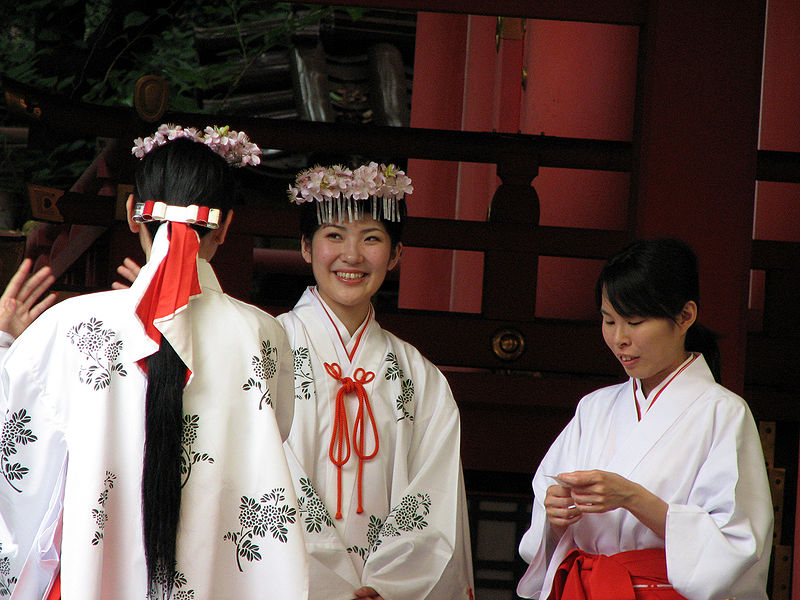
Miko at a Shinto shrine
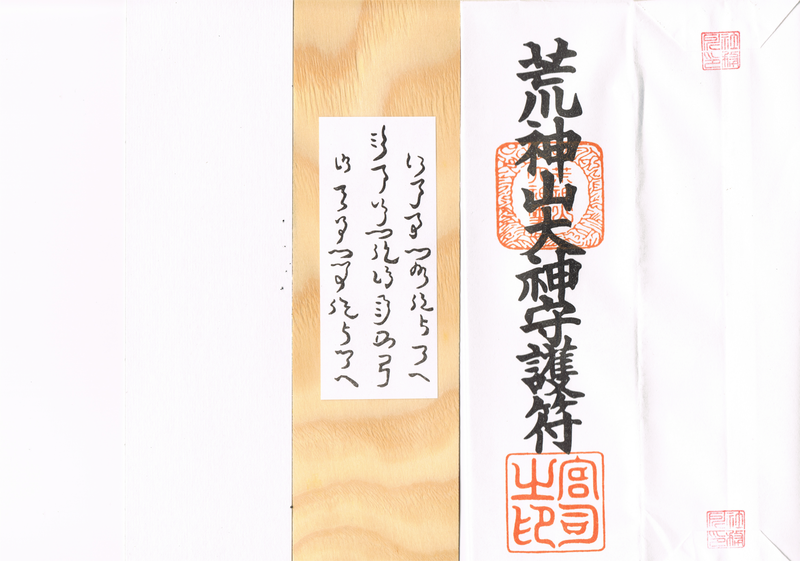
Example of an Ofuda
As Paracelsus pointed out, Rao might actually be a Buddhist priestess. Example:
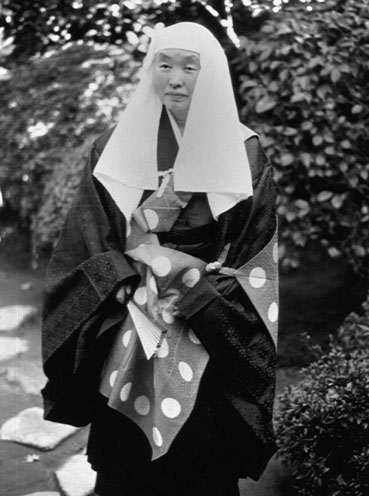
Buddhism and Shinto dovetail very closely in Japan, so she could be a little of both!
The Lucky Mallet
The Mallet appears in the tale of Issun-Boshi (Issun's mythological analogue, you may recall).
In the story, an elderly childless couple prayed fervently for the gods to bless them with a child, no matter how small. Though the woman was past childbearing age, eventually, a small son was born to them. A small son indeed: the babe was no bigger than his father's thumb.
Despite the boy's size, his parents were delighted to have him and they doted upon him. One day, the lad realized he'd never be big like his father, so he decided to go adventuring. He armed himself with a sewing needle, and set off down the river in a soup-bowl boat, using chopsticks for oars.
When he arrived in the big city, he went to the local Daimyo and asked him for work. The Daimyo was amused by the pint-sized "adventurer," and sent little Issun-Boshi to accompany his daughter, a lovely princess, as her playmate.
During their travels, the princess and Issun-Boshi were set upon by an Oni (an ogre, pretty much). Issun challenged the Oni to battle, to which the Oni responded by swallowing our pint-sized hero! However, that was not the end of our hero! He poked the Oni repeatedly with his needle sword, until the monster spat him out. Feeling sick, the Oni fled, dropping a legendary artifact: Uchide's Mallet, a magical hammer said to be able to make small things big! To thank him for saving her, the princess used the mallet on Issun-Boshi, growing him to normal human size.
Issun-Boshi and the princess remained close friends thereafter, and eventually wed when they came of age.
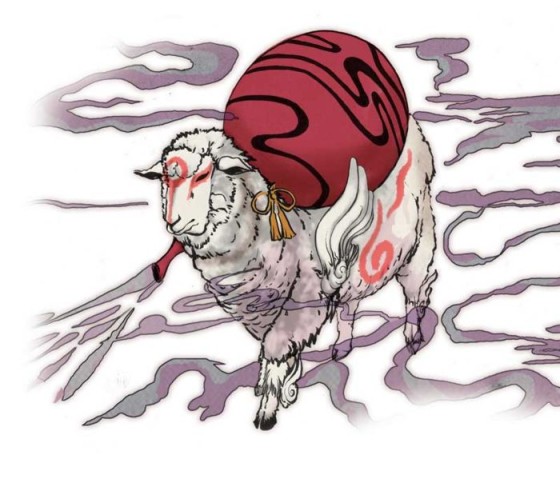
The sheep (or goat, or ram), god of Mist. "Kasumi "means mist.
Sheep traits: Righteous, sincere, sympathetic, mild-mannered, observant, artistic, intellectual, ingenious, innovative, creative, mothering, peaceful, and generous. Can be indecisive, over-passive, worrier, pessimistic, sensitive, shy, and weak-willed.
The ram, monkey, and rooster finished right after the other. They had all helped each other get across the river. The three animals rode across together on a raft. The ram helped to clear away the reeds on the way across.
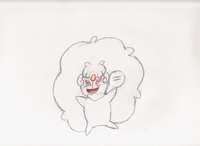
Whimsugami
Miscellany
Inaba- One of my sources claims that the lost rabbit Inaba is named after the Clover CEO: Atsushi Inaba.
However, the Okami Artbook (which I got for Christmas
 ) says that he's based on the tale of the Inaba Rabbit, which cokerpilot outlines below:
) says that he's based on the tale of the Inaba Rabbit, which cokerpilot outlines below:cokerpilot posted:
The White Rabbit of Inaba
While he was yet a young man, Okuninushi was not liked by his brothers, and treated as a slave. This was too bad, since Okuninushi was a kind and gentle person. Let's look at the legend of, "The White Rabbit of Inaba." In those days, a story of a lovely princess of Inaba, named Yakami, was being spread around the country. The brothers of Okuninushi thought they would go, and one of them would be chosen to marry her. They ordered Okuninushi to get ready, and then set off on the journey, with him carrying all the baggage.
On the way to Inaba, the brothers met a white rabbit who was suffering terribly from having his skin torn off. The brothers thought this was a comical situation, so they told the rabbit to wash off in salt water, and lie on top of a hill to heal himself. The rabbit did as it was told, and was soon suffering more than before, as his skin cracked and bled. This was the situation that met the eyes of Okuninushi when he came along later. With so much baggage to carry, he could not move fast. The rabbit was crying, and shedding great tears at his terrible pain. Okuninushi asked him what had happened.
The rabbit told Okuninushi that he had been living on Oki Island, and had wanted to see the Princess Yakami, so he had told a wani (shark)* that he thought his family was not as numerous as that of the rabbit's family. The wani disagreed, so the rabbit told the wani to have his family line up from Oki Island to the shore of Inaba, and he would count them. The wani thought this was a good idea, so he did as the rabbit directed, and lined up his whole family from Oki Island to the shore of Inaba. The rabbit then ran gleefully across the backs of the wani to the other shore. Unable to resist the temptation, he laughingly told the wani that he had tricked them, and they were really foolish! The wani were understandably shocked and angered at his trick, and before he could escape, they caught him and tore off his skin!
As a result, he was in great pain, and asked Okuninushi for help. Okuninushi told the rabbit to wash off in fresh water, and roll in the seeds of a cattail reed. The rabbit did so, and was cured. He was so grateful to Okuninushi that he told him his brothers would never win the hand of the Princess Yakami, but she would choose Okuninushi to be her husband. This happened as the rabbit had said, and Okuninushi married the Princess Yakami. There is a statue on the left of the entrance to Izumo Taisha Shrine, that shows the scene of the rabbit telling Okuninushi's fortune.
*Wani, is "shark" in this legend. In reality, however, in Japanese, it means "crocodile." I believe that wani is really crocodile, and that real, ocean-going crocodiles existed in the Japan Sea in those ancient days. They still exist in the South Pacific. At that time, the weather must have been much different. In recent history, whales and other arctic animals have visited this area. These days, neither of these events happens any more. The stories still exist in legend, however.
Lucky Cat
The cat statue in the Emperor's strong box is a Maneki Neko, or lucky cat. These are common Japanese statuary, usually made of ceramic, said to bring good luck to their owner. The usual depiction is a calico cat beckoning with one hand, often with a coin medallion around its neck. The coin is early Japanese currency. The exact value doesn't matter. It symbolizes "a lot of money," in other words, wealth and good fortune. Lucky cats are often found at the entrances to shops and restaurants, and in people's homes.
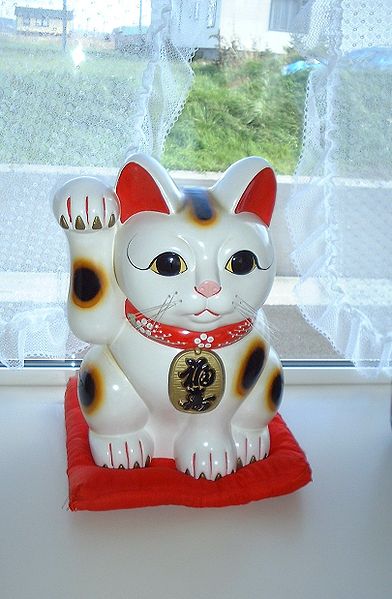
Example of a Lucky Cat
The Pokémon Meowth is based on the Maneki Neko.

JackGeneric posted:
Just watched 4.4 and you said you didn't know what those bamboo things are called. They're called sōzu, and the noise they make is supposed to frighten any deer that might be grazing on the garden.
Good to know! Thanks for straightening me out. Odd that Issun said those things make soothing noises, then, if they're meant to frighten deer.
Rangpur posted:
Welp, just popping in to say I ended up starting a new game thanks to you. Like, from the very beginning. Had a New Game+ sitting right there and I started over from scratch. I don't even know why. Might have something to do with starting to play and not bothering to look at the clock until it's 4 AM. Real easy to get caught up in this one.
I should be irked. Though it is sort of gratifying to tear through the early parts of the game with the knowledge I picked up last time 'round! Anyone remember if any of the stray beads are permanently missable?
This is what I like to see, people playing the game because of this LP!

As mentioned, none of the stray beads are permanently missable, but one of the animals is. If you've played game before, you probably know which one.
Paracelsus posted:
Man, I would have been so tempted to just grab that golden ink pot. So awesome.
I'm saving to get that one important thing that costs 200 Demon Fangs.
 Don't worry, though, I'll get the Golden Ink pot!
Don't worry, though, I'll get the Golden Ink pot!quote:
And saying that there's a lot to do in Sei-An City at this point is a bit of an understatement.
Oy, tell me about it! I recorded over two hours of footage last night just faffing around in The City. Two hours! Granted, some of that will be cut, but not a significant portion of it. I generally know what I'm doing.